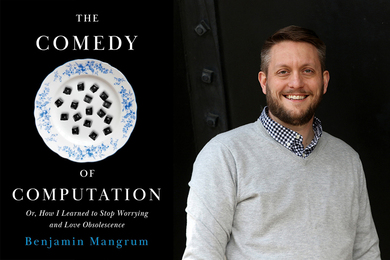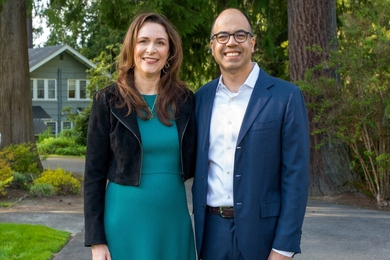It began with a bowl of soup. When Pyae Phyo was a young girl in Myanmar, her older sister pointed out the circles of oil floating in the steaming broth and asked her why she supposed the water and oil did not mix. The ensuing explanation of the differing polarities of water and oil sparked in 5-year-old Pyae a lifelong interest in uncovering what she calls “the basic properties of everyday materials.”
Now a graduate student in the Magnetic Resonance Division of the MIT Plasma Science and Fusion Center, under the supervision of Professor of Chemistry Mei Hong, Phyo continues to ask questions about everyday phenomena. Most recently her questions revolve around plant cell walls: how they are created, and how understanding their molecular structure could aid in developing sustainable biofuels. She’s finding the answers with the help of solid-state nuclear magnetic resonance spectroscopy.
Phyo first learned about NMR as part of a university summer research program. She had arrived in the United States for the first time in 2011 to pursue a fully funded undergraduate degree at Berea College in Kentucky. Having grown up mainly under a military government with an educational system that promoted rote memorization over practical, hands-on scientific experience, Phyo was eager to study in the United States, where laboratory work is part of the curriculum. After her first year in college, her academic advisor, Professor Jay Baltisberger, invited her to join a summer research program at the Ohio State University (OSU) in the Grandinetti Lab, where he was taking his sabbatical year.
The summer study of silicate glass introduced her to a tool for seeing and analyzing the hidden structures that make up the materials of everyday life. NMR measures nuclear magnetic interactions in a material to gain understanding of its molecular structure, information that could be important in producing new medicines, predicting drug interactions, or developing new materials and substances, like biofuels.
“I got a lot of experience at OSU seeing how my colleagues would troubleshoot and fix NMR probes and solve issues with the experiments, how they designed experiments to answer specific questions, and how they analyzed and interpreted the results.”
After a week in the program she had learned enough to oversee the project alone while her advisor and colleagues attended a conference. The program became her summer home for the next three years.
Phyo chose to continue her studies at MIT, drawn by what she felt would be the most challenging and motivating academic environment. The larger city environment was also a challenge, inhibiting her at first from venturing out after dark. Eventually familiarity with MIT and her Hong group colleagues, as well as enjoyment of the Charles River, the magnolias on Commonwealth Avenue and plentiful Asian cuisine, reversed her original fears.
Phyo’s research focuses on understanding the fundamental plant cell wall structure in order to give critical insight into how to convert plant waste to biofuel. She employs and develops sophisticated two- and three-dimensional solid-state NMR techniques to examine the plant cell wall structures at the molecular level.
“Back in Myanmar,’ she notes, “our main staple is rice, and we burn the majority of rice straw to get rid of it, polluting the air in the process. Creating a carbon-neutral method of turning this refuse into liquid fuel that could be used for combustion engines would be revolutionary for the environment and the economy.”
To that end, she studies the molecular structure of the plant cell wall to better understand how plants grow. Unlike animal cells, plant cells have walls that provide their main structural support. But plant cells must expand these walls for growth to occur.
“We wouldn’t have either the giant redwood tree or the massive Aspen colony without this extraordinary ability,” she explains.
The major components of the plant cell wall are well known. Cellulose, composed of a long chain of glucose molecules, forms the main scaffold of plant cell wall structure by forming microfibrils that provide strength and rigidity. But exactly how is cellulose synthesized and bundled together in microfibrils to strengthen the wall, while still allowing plant growth through complex interactions with other polysaccharides?
Studying this process and developing a universal 3D molecular cell wall model is the focus of Phyo’s research. She says that having a 3D model would aid future work on genetically engineered plants for biotech, agricultural, and energy applications.
“We see a two-dimensional structure in a textbook,” she notes, “but we don’t know if it is true or not. It is an approximation of what we think is happening. There are so many different types of polysaccharides such as pectin, cellulose, hemicellulose. But how are they spatially arranged? Where is the cellulose? What is attached to it and where?”
Understanding the 3D structure of a cell wall would make it easier to manipulate specific molecular bonds to create novel materials for agriculture and biofuel applications. Phyo likens it to removing a door from its frame.
“If you want to get rid of a wooden door, you could burn it, or chop it, again and again. You would eventually succeed in breaking it down. But if you know the structure of the door, how it is assembled, and where the hinge is, you can quickly take it apart. With cell walls, if you have a 3D reference system for its formation and structure, you know exactly where to attack.”
Phyo is not alone in her quest. While working in the Hong group at MIT to conduct cutting-edge solid-state NMR experiments, she is part of a dynamic Energy Frontier Research Center, funded by the Department of Energy. The Center for Lignocellulose Structure and Formation includes collaborators from Penn State, Oak Ridge National Laboratory, the University of Cambridge, and other institutions, all working to increase understanding of cell wall formation and structure in order to lay a foundation for future developments in genetically engineered plants for biotech, agricultural, and energy applications.
Phyo is also not alone in the United States. Although her parents remain in Myanmar, her three siblings have all come to the United States to study science. Her older sister, who excited her about the chemistry in a bowl of soup, received her own PhD in solid-state nuclear magnetic resonance spectroscopy; her younger sister studies biochemistry and molecular biology as an undergraduate student in Ohio; and her brother is a third-year PhD candidate at MIT, part of the Willard group in the Department of Chemistry.
As Phyo prepares to defend her dissertation and move on to a position as senior scientist at Merck in New Jersey, she remembers fondly the walks along the Charles, past the rhododendrons or under the magnolias, elements of her everyday life that have become familiar.
“You have something around you all the time, like a plant or a leaf or a flower, and you ask, ‘What is inside this?’”
Her research, which has revealed some molecular details of the cell walls inside these plants, is helping to answer that question.









